
The spit roasted lamb that is prepared in many parts of the Aysen region in Chilean Patagonia, the preparation of dried mussels along the coast and the work with the clay from the earth of the region are some of the activities that depict the different lifestyles of Aysen.
Aysénprofundo is a journey that takes us into the Patagonian reality, introducing us to people who still struggle to live as the land has taught them. With aysénprofundo we will enter the most hidden corners of a region that refuses to be dominated and which in turn has molded the identity of its inhabitants. A tribute to those who make us proud because they are the reason why “the Patagonian” is synonymous with struggle, affection and humility.
Aysénprofundo is a multimedia document containing video, text, audio and image that bring us into the workshops and homes of the region, revealing secrets of crafts and traditions to younger generations and to those who wish to discover how people live in the southern lands of Chile.
We invite you on a journey through our land
We invite you to aysénprofundo
Our community is in development.
Soon you will be able to interact with our website to tell your stories,
experiences and issues related to the Aysen region.
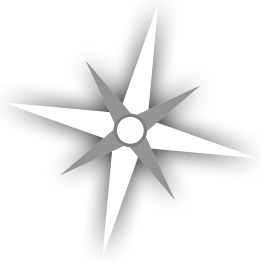




The drying of mussels is one of the most traditional tasks within the coastal communities of the Aysen region, especially in the archipelagos of Guaitecas. Even if it first appeared as a self-supporting activity, perhaps already in prehistoric times, its origins as an economic activity by the producing families goes back to the first half of the twentieth century. At that time, small and medium companies from Chiloé started to exploit the resources such as cypress trees or seal furs, by employing and supplying crews from Guaitecas with stocks and tools for working periods that could last months.
They thought that the new resources together with the production of dried fish, could also be successfully marketed in Puerto Montt. Thus, many working families in coastal communities, capacitated by traders from Chiloe, began to exploit the mussel. The production of this food became an important source of income for families in the coastal area of Aysen for many decades.
However, the times of plenty were bound to finish, and the process of drying mussels again became an activity oriented towards self-consumption or local barter. Today, this activity, as well as others associated with shellfishing, is severely limited by the presence of toxins in the water “marea roja”.
Nevertheless, the profession and all its required knowledge is kept alive in the communities.
References: Saavedra, Gonzalo, 2007.
“Las economías silenciosas del litoral aisenino”. in Otras Narrativas en Patagonia. “Tres miradas antropológicas a la región de Aisén”. Ñire negro Editions. Coyhaique; Ponce, Viviana et al, 2009. Guaitecas: Paso al sur. Desktop publishing.
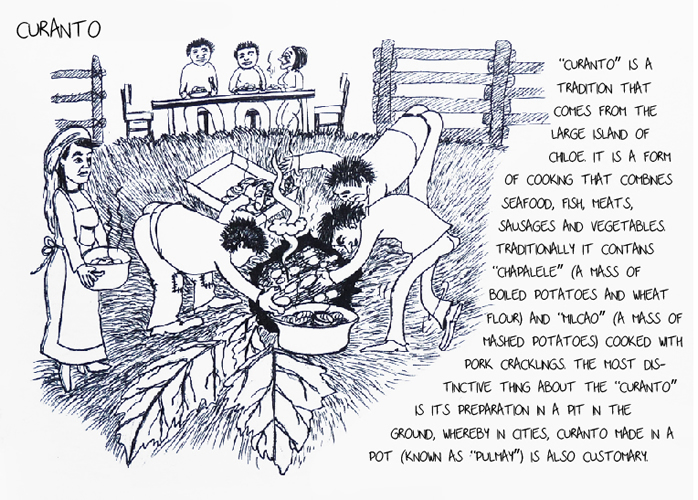
Source: Manual de Carreño de la Patagonia Aysén, 2010, Nelson Huenchuñir, Patricio Segura
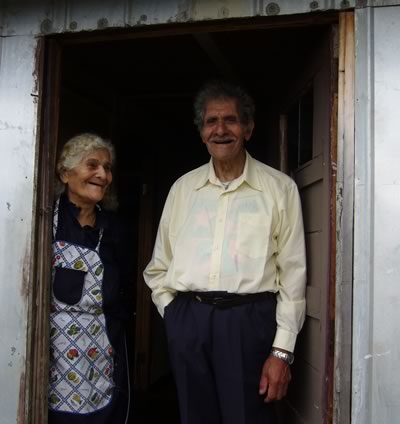 Don Juan was born and raised in the village of Repollal Alto. Together with his wife, the grandmother "Llelleo", as everyone knows her, he formed a family of four children. He remembers the story clearly when his grandfather and his father, Basil and José Miguel, came to Repollal Alto in 1907.
Don Juan was born and raised in the village of Repollal Alto. Together with his wife, the grandmother "Llelleo", as everyone knows her, he formed a family of four children. He remembers the story clearly when his grandfather and his father, Basil and José Miguel, came to Repollal Alto in 1907.
Don Juan and grandmother Llelleo are cheerful, of deep values and possess a noble soul and quiet smile. They are perhaps one of the finest examples of the sense of community that inhabits this village. A sense in which solidarity and mutual aid is above any possible differences, a sense in which hope is more important than oblivion. So is the family Vera, hard working and determined.
With joy, Don Juan recalls past times. Times when life was hard. But these times aren’t over yet, because this man, with his eighty-three-year history continues to go fishing together with his fellow colleagues with an enduring force.
With the same energy, Don Juan recalls the stories that his grandfather told of pirates. As if it was yesterday he recalls the stories of the legendary Pedro Ñancupel and Carmelo Nahuelhuen, both dedicated to stealing the skins of sea lions that the hunters had caught, travelling from the island of Chiloé in their boats and willing to sacrifice everything in pursuit of their mission. Don Juan sings and laughs with the ballads about these bandits, the same songs he learned when he was only ten years old, more than seventy years ago.
Both he and Llelleo look back on a lifetime full of memories, a time when fishing was done with bare feet until shoes were made of sea lion skin “hojotas”, the same shoes they wore to the celebrations of the national festivities on the 18th of September.
A time when women worked until three days before delivery and the newborn ate seaweed, luche, fish and potatoes. Maybe that's why they laugh freely about the new customs and modern care of the mothers today.
Don Juan and the grandmother laugh, happy and noble. Laugh with the joy of the old, looking straight ahead and without fear, as a new day says goodbye to Repollal, the sun beating down over the canals in the same instant that the last afternoon cup of Mate says goodbye to these two giants.
Ponce, Viviana, Pastrian, Ignacio. Life History of the Ancient Guaitequeros. Melinka, Chilean Patagonia, 2007.
Photo: Viviana Figueroa Ponce.
We are at the smokehouse of the Vera family in Repollal Alto, a small village of 25 houses and 68 inhabitants, 220 km from Coyhaique. Repollal Alto is located on the west coast of Ascension Island, some 15 km from Melinka, county capital and largest settlement in the archipelago of the Guaitecas. Repollal has a school, a church, a small shop, a neighbourhood committee, a cemetery, several piers and a soccer field on which sheep normally graze.
Ricardo Henriquez, Don Juan and Don Checho Vera and Don Porfirio Cardenas all participate in drying the mussels.
Repollal is situated in front of the "Canal Poquitin" which not only enables the collection of shellfish and the transport of firewood by boat, but also provides a sheltered climate for the cultivation of vegetables and fruit trees.
In Melinka and Repollal 31% of the population is involved in traditional fishing, the main source of employment in the area. Despite the current links that Melinka has with the mainland by sea and air, the weather can often prolong the journeys or even cut all lines of communication.
We are about 15 km (approximately 9 nautical miles) north of Puerto Cisnes, in the area called “Casa de Pesca”. Doña Emma Hernández and Don Celestino Ancamil are the owners of this land whose only access comes from the sea. They arrived in the 1950s, and were traveling to the mainland by rowboat until 1981, when they acquired their first outboard motor.
For more than 30 years the original settlers of the area have longed for the construction of a coastal road, a project that for political reasons has not yet been done.
Emma and Celestino are virtually self-sufficient on their 350 hectares of land. They have spring water and solar panels, cows and lambs, chickens, hens and an extensive garden with fruits and vegetables. In their home they make cheese and butter, spin wool and manufacture wood and leather furniture.
During the summer holidays their daughter, son in law and three grandchildren come from Puerto Cisnes to share the country life with their grandparents. The children have fun picking fruit, lassoing sheep “pialar” and driving cows for milking. Currently their main source of income is the sale of beef, but recently they built a second house next door, so that in the future they can also dedicate themselves to rural tourism.
In the Aysen region handmade cheese is usually produced by women. The techniques used in the process are a combination of indigenous Patagonian and European knowledge. There were already references to homemade cheese in various parts of the region in the early twentieth century.
The process begins with milking cows. The collected milk is deposited in a receptacle or wooden tub and whey is added, prepared with a serving of milk and curds that can be purchased commercially or prepared directly from natural products used in the field. The whey is used to ferment the milk – the separation of water and milk fat. Once achieved, all liquid (buttermilk) is extracted by placing the curds in a flour sack and pressing out the liquid. Next the solid curds are washed with very cold water to facilitate their contraction. This process of extracting the liquid should be repeated to remove whey excess from the curds.
The next step is placing the curds in a wooden tub and adding brine (salt water) to give the necessary flavor as well as to subsequently preserve the cheese. The curds is then placed in small wooden or plastic moulds with round or square holes called “doeras”. These moulds are pre-coated with cotton cloths which allow the whey to drain and later facilitate the removal of the cheese from the “doeras”. To attain the greatest extraction of liquids and to compress the cheese, the “doeras” are covered with weights, i.e. stones or other elements. After a few hours the cheese is ready and is removed from the doera to be placed on a grid of “colihue” or “quila” (regional wood), called “zarandas”, which hang from the rafters, over the stove or in the cheese room to permit the draining of the cheese.
After a few days, weeks or even several months, according to the consumers’ taste, the cheese is ready for consumption.
In the region there is currently a commercially oriented artisan cheese factory in the town of La Junta, whose owners are the Gallardo family. Their cheeses are sold in various locations and even in the Lakes Region (in the Center of Chile).
Source: Galindo, Leonel, 2004. Aisen y su Folklore. Desktop publishing.The Rio Cisnes Ranch has its origin in the land grants issued by the State of Chile to Joaquín Rodríguez Bravo and Antonio Allende in June 1903. These people transferred the granted rights to the “Anglo-Chilean Pastoral Company”, a livestock company formed to exploit said granted lands. Thus, in 1904 the initial infrastructure was expanded, very rustically at first, to begin the work of mainly sheep breeding.
The Rio Cisnes Ranch is one of three large ranches that were formed in the territory of Aysen. The other two were the “Industrial Society of Aisen” that held land in Puerto Aysén (offices and port), Coyhaique, Coyhaique Alto and Ñirehuao (1903-1950), and “Ranch Posadas Hobbs & Co” (1921-1950), which operated in the Baker Delta, Chacabuco valley and Baker River area (up to the rivers source), inheriting a previously failed venture lead by the “The Baker Exploiting company” (1904-1908) and continued by the “Valle Chacabuco Ranch” until the of this century.
By 1908 the ranch already had several facilities near the border with Argentina. Already in 1924, under the management and ownership of John Dun (former manager of the “Industrial Society of Aisen” in Puerto Aysén and Coyhaique), the ranch passed into the hands of a new legal figure, the “Rio Cisnes Ranch Cattle Company”, which operated regularly until the Sixties, a period in which there was land reform and the property was affected by successive expropriations and other modes of handing over land, first to a small group of owners and then to several families in the area. The “Rio Cisnes Ranch” today has an area of about 130 000 hectares.
Source:
Soto, Patricia, 2009. Expediente Técnico Estancia Río Cisnes. Autoedición.
Ivanoff, Danka, 1997. Lucas Bridges, el señor del Baker. Autoedición
Galindo, Leonel, 1996. Aisén, Voces y Costumbres. Ed. Orígenes.
The wool fiber has an elongated molecular structure, made of chains of cells that are joined together in a spring, which gives the fiber its elasticity, i.e. the ability to straighten and twist without being distorted, and recover its original form after stretching.
Physical properties
Hygroscopicity
Retains water up to 40 or 45% of its weight. Hard to dry. The water absorption capacity of the fiber does not mean that it gets wet. The water does not adhere to the surface of wool but rather is introduced into the fiber. Wool that appears dry may actually contain up to 15% water.
Thermal insulation
The volume of the tissue makes the heat exchange between one surface and another difficult. Spread on a flat surface every fiber of 1 kg of fine Merino wool, it can cover an area of 200 m2. This gives an idea of how much air a fabric composed of high quality wool can hold and trap. This large amount of air trapped in the interstices of the fibers therefore reduces the thermal conduction. The second factor is the spongy surface of the tissue that, by not adhering to the skin, leaves space for the first layer of air.
Absorbs transpiration and repels water
When a woolen garment is worn, its property to attract moisture absorbs sweat from the skin, reducing fermentation and thus the characteristic smell of fermented sweat.
Fire resistant
Wool is not flammable. It does not melt and thus will not stick to skin when burned.
Elastic and stable
Inherent characteristic of its natural curling. Does not deform easily at points of continuous contact such as elbows or knees. It has a great power of recovery or resilience. A woolen garment hung overnight "recovers" its original shape remarkably well.
Felting power
Fibers are irreversibly intertwined through friction + pressure + moisture. It usually occurs when washed in a washing machine. By eliminating the pressure on the fibers, they do not recover their original position. By repeating this method a very strong felt can be manufactured which is characteristic to wool and other hair with a scaly surface.
This factor is exploited for the use of scrap wool fibers, which are too short to be spun. This felt is used to make hats, coatings and acoustic insulation.
Resistant to acids
Wool is resistant to acids, but not alkalis, which can even dissolve wool.
Static resistant
This property, combined with its hygroscopicity and elasticity, gives the wool another excellent and exclusive feature; to be soothing and pleasant to the touch.
Can be moth-eaten
But modern moth proofing methods have significantly reduced the vulnerability of wool to moths. This risk is no longer a concern when making or acquiring a piece of woolen garment.
Yellowing under the action of sunlight
Source: http://www.edym.com/CD-tex/2p/matprim/cap05/cap05-1.htm
Wool quality is directly related to the breed of sheep from which it comes. Wool is classified as very fine, fine, medium and heavy. The breed that produces the best quality wool (very fine) is the Merino, followed by Corriedale (fine) and Romney Marsh (medium). Their efficiency is 85%, 70% and 60% respectively.
In the Aysén region the breeds Corriedale and Merino-Corriedale mix were introduced. To a lesser extend other breeds have been introduced in order to generate dual-purpose sheep: meat and wool. There are also a few herds for milk production.
Sources: http://es.wikipedia.org/wiki/Lana; www.inia.cl; www.ag-riobaker.cl; www.ag-riobaker.cl
The shearing team “comparsa” is a group of workers informally organized to perform all the tasks associated with the work of shearing, mainly in large ranches dedicated to sheep breeding, “Estancias”. In terms of the number of people involved, shearing is one of the most complex tasks in sheep management.
From the late Nineteenth Century, many sheep shearing teams were formed on the Island of Chiloé work on the different farms of the region. As these teams of “Chilotes” traveled throughout Patagonia, Chiloen settlements were established.
A “comparsa” consists of:
-Foreman: organizes the team, and encourages families, friends or acquaintances to participate in a task previously negotiated. He is also the one who makes the deals with the owner of the wool.
-Shearman: dedicated to removing the fleece from the animals by “tijerones” (traditional technique of scissor cuts) or machinery (mechanical shearing systems). In some communities in the region the scissor technique is still used because the number of animals is very low. In the big ranches machines are used.
-Playero: responsible for counting (deposits a coin in a receptacle located in front of the shearer) and lifts the fleeces shorn by each shearer. The playero is also in charge of keeping the “beach” clean, the area where the shearing is done inside the shed, either on a table or cement floor, depending on the type of construction of the enclosure.
-Vellonero: Picks up the fleece and delivers it to the “prensero”.
-Prensero: responsible for reviewing the fleece and then placing it in the press to make bales that typically weigh about 200 kilos on average.
-Gripper: works outside the barn and delivers the animal to the shearer, hobbled if they so request.
-Cook: person in charge of feeding the entire company. Who should be up before everyone else to prepare breakfast and is responsible for preparing all the meals for the team.
Source: Galindo, Leonel, 1996. Aisen, Voces y Costumbres. Sources Ed.
The management of sheep in the region is organized to ensure that the animals thrive. The land is divided into square pastures bounded by wire fences. There are pastures for breeding rams, for sheep without lambs, and others for those that have lambs. This division takes place between September and December, during the lambing season. In May, the rams are brought together with the fertile sheep for breeding. The lambs are born after 5 months.
There are also pastures for holding the sheep during their gestation period. These pastures have a better quality of grass and are generally closer to the family home or farm buildings.
Animal management also includes various tasks to keep the sheep fit and free of diseases. The shearing of the eyes “pelada de ojos” is done to clean around the animals eyes to keep them free of sand, spines and other materials present in the field, which may obscure vision. The “arse shearing” is done for two reasons, to clear away the feces, “cascarrias”. To enable mating, the stomach area of the males and the genitalia region of the females are also trimmed.
To avoid ticks and scabies the sheep are dipped in a bath “desparasitación”, at least twice a year, in May after mating and in January after shearing.
Source: Galindo, Leonel, 1996. Aisén, Voces y Costumbres. Sources Ed.We are 230 km from Coyhaique, in the shearing barn of the "Rio Cisnes Ranch". 120 people work here during the shearing season in December. The work day of the shearing company starts at 6.45 am in the morning and ends at 7.15 pm. Throughout the day a break of about 1 hour is taken every 2 1/4 hours (called “the quarters”), usually for eating some lamb meat and sharing a cup of Mate tea with fried cakes.
During the shearing season a total of 90 lambs are eaten in the farms canteen.
Currently, the 130.000 hectare ranch has 40.000 sheep. The ranch extends from the Argentinean Pampas in the east to the Lake Carlota Reserve in the west.
The Rio Cisnes Ranch has a permanent population of 55 people, there are two streets with private dwellings, a store, a chapel, a post office, a petrol station, a school, an airport, a veterinary surgery, a canteen and a barn for shearing the sheep.
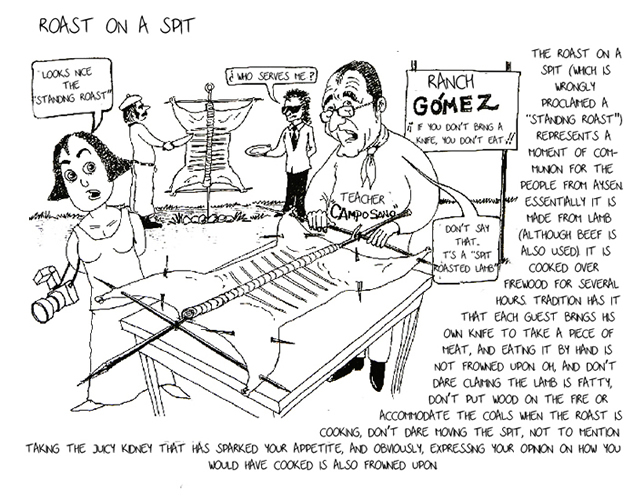
Source: Manual de Carreño de la Patagonia Aysén, 2010, Nelson Huenchuñir, Patricio Segura
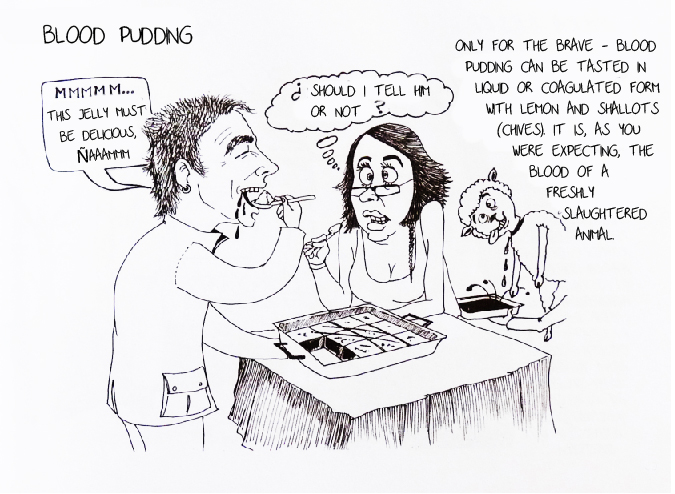
Source: Manual de Carreño de la Patagonia Aysén, 2010, Nelson Huenchuñir, Patricio Segura
We are in "Coigue Huacho" the land of Ruben Redlich and Pola Cohen, 10 km from Coyhaique, near the main road to Aysén, on the country road to Mañihuales. Their land measures about 5 hectares in total. Fruit trees, flowers, berries and other regional fruits surround the small house where they live. 4 years ago Ruben and Pola made the decision to leave Coyhaique and move to the countryside, where they currently live with Mr. Miyagi, who helps them with the daily tasks.
Among the animals that give life to the place are the cow "Filomena", the calve "Golondrina", the horses "Rayoluna" and "Margarita", their dogs "Polito", "Envido", "Talcual" and "Brundi" and a frisky boar named "Alinco".
In their fields they also raise pigs, sheep, rabbits, chickens, geese and ducks, and organically grow vegetables and flowers. Ruben, apart from working the fields, is often hired to cook Patagonian barbecue at events, and also sales firewood during the summer.
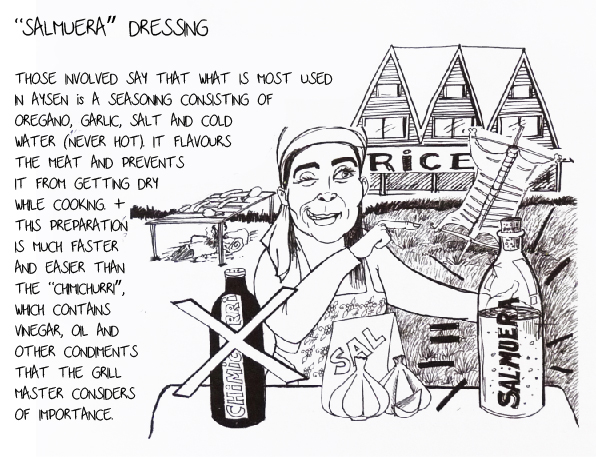
Source: Manual de Carreño de la Patagonia Aysén, 2010, Nelson Huenchuñir, Patricio Segura
Considering the importance that mate has acquired in the regional context, we will rest for a moment to analyze the levels of meaning that its practice has acquired in relation to the identity of Aysén inhabitants.
Drinking mate is a practice that structures the day for many of the people and families in Aysén.
Its consumption is common for a large part of South America, which has caused it to become a cultural practice that gives an identity to a variety of social groups. In Aysén, drinking Mate has a number of particularities, which distinguish it from other territories in the area. However, we are more interested in talking about the social act that surrounds the consumption of this South American drink.
In the region, drinking Mate tea is a social act that structures the day into specific moments: Mate in the morning prepares the start of the working day both outside and inside the home (for housewives, pensioners, the unemployed). A Mate session before lunch also marks the lunch break and in the afternoon many people drink Mate again before supper.
This rite functions to structure time within households, becoming a reference for cultural identity, a time to transmit and negotiate family values and social discourses, a time to reflect on the changes that are experienced and shared as a people of the region.
Notwithstanding the particularities of consumption that distinguish different groups through the use or non-use of sugar and herbs as additives, Mate condenses culture and identity: consuming it denotes attachment to territory and the cultural patterns within it.
To share Mate with new arrivals or visitors to the region denotes acceptance and an invitation into the Patagonian community. While rejecting this gesture is not socially sanctioned, accepting the invitation will always be seen as a contribution to the maintenance of regional identity.
Strictly speaking, Mate is an imported product. It arrived with the first migrants who came to Aysén from the east. Even today all its components (Mate herb, straw, vessel to prepare the infusion) come from outside the region. However, the act of consuming Mate according to certain social and cultural patterns is an icon of tradition, and forms one of the central tenets of cultural identity in the Aysen region.
Source: Osorio, Mauricio et al 2009. Aysén, Matices de una identidad que Asoma. GoreAysén-IlpesCepal.
Available at: www.turismosustentableaysen.wordpress.com
The workers were making a path, which they would later turn into a road linking Lake Vargas with Cochrane. Ten hard men used to such hard work and such a harsh climate, enduring the wind, frost and snow without making hear any complaints. Usually, these groups had a cook, but since they hadn’t found anyone yet, they remedied the inconvenience by taking turns, one day one, one day another. Today was Coyopaes’ turn, who was using the sun to tell the time. Everybody else had a watch, either a wristwatch or a pocket watch, some even had batteries; which where then just appearing.
At this very moment Coyopae looked at him with an expression of amusement and intrigue.
The young man was a little disoriented, but retorted - What happens on cloudy days then? The men looked at each other and erupted into uproarious laughter, then the makeshift cook said - On those days I let my stomach guide me.
Esteban returned to the fray.
The younger man continued to insist – Just buy yourself one, I will teach you how to read it.
Esteban continued his work, thinking about the words of his friend. Although it seemed crazy, he could be right, and the Chinese and Japanese are smart, they invent amazing devices every day! Why couldn’t they make a clock that speaks the time? Chuckling at the thoughts of his companion, he looked at the sun and kept working.
Between blades and picks the days passed by until the road was taking its final steps when the Vargas river finally appeared in front of them.
Some renewed their contract for another road section, and others, among them Esteban decided not to work any longer. The young man had never been able to get used to this hard and sacrificing work. He was not made for it, and moreover he could no longer resist the rain, cold and frost, but he was still happy. He had learned something, and he had made friends, especially with Coyopae, who when they said goodbye gave him the address of his house in Coyhaique, inviting him to pass by some day when he came to the city.
Esteban returned to his hometown of Concepcion. He soon found work selling electrical appliances, which obliged him to travel to different places.
After a while, the salesman went to Valparaiso and by chance stepped into a shop where they sold everything: toys, clothes, radios, clocks, and everything one might require. Suddenly something came to his mind and he went to the section with the clocks. There where clocks for every taste, pocket clocks, alarm clocks, wall clocks, and so on. Examining the watches and lost in thought, he was startled when he heard a voice saying, “half past eleven”. The voice emanated from a beautiful wall clock.
They saleslady saw him, came up and asked - What can I do for you, Sir?
Esteban was very excited because he thought of his friend down in the South.
The employee showed him a wrist watch, pressed a button and it sounded, - Five forty-five, pm.
The young man selected it, the hour and date were set, he gave his thanks and left feeling very satisfied with his purchase.
When he had holydays he went to Coyhaique, where Coyopae lived. Once in the city, it wasn’t hard to find the home of his old friend.
He received a big shock, which gave him immense grief and disappointment, when Coyopae’s wife told him that Coyopae had died a year ago in a landslide cloth to Vargas. Since he died in winter his body had to be buried in Cochrane. She wanted to bring him to Coyhaique, but didn’t have enough money. The poor, afflicted woman told the young man, - My dear old husband had to stay there, I went to see him twice and now in November I want to go again.
Esteban was visibly moved and with moist eyes took money from his purse and handed it to the lady along with a little packet.
Esteban, with a shattered soul, said goodbye to the woman and with heavier steps than usual went to the hostel where he was staying.
At that very moment a siren sounded. The young man, despite his sadness, looked at the sun and shouted, “It’s twelve o'clock, Coyopae!”
The fried cakes are one of the traditional recipes in the countryside, for rainy days in the Aysén region.
Preferably accompanied by Mate, butter, jam and cheese it is one of the most common recipes prepared by the Patagonians on those days when rain permits little or nothing to be done other than to spend time inside with the family.
The preparation consists of mixing flour, water, salt and fat or lard in a bowl to create a soft dough that is stretched and then cut out to be fried in beef, pork or lamb fat.
Ingredients:
1 kg of flour
300 g of pork fat
4 teaspoons of salt
300 ml cold water
Beef, pork or lamb fat to fry (or vegetable oil)
Preparation:
Mix salt with flour and knead in the fat with the fingers, then add cold water to obtain a smooth, soft ball. Place dough in refrigerator for half an hour. On a table sprinkled with flour use a rolling pin to stretch out the dough until it is one centimeter thick. Cut dough into diamond-shaped pieces with a knife and prick with a fork. Fry in plenty of fat or oil. Take the fried cakes out when they are golden and tender.
The jam accompanies the daily bread and the traditional fried cakes. It is one of the most favorite recipes of Patagonian families.
Fruits abound during the harvest season, especially in the warm microclimate around Lake General Carrera. The plum jam allows for its preservation during the rest of the year.
Ingredients:
1 kg plums
900 g sugar
1 cup of water
Lemon juice
Cinnamon to taste
Preparation:
Wash the plums with water, pit and cut them into chunks, pour them into a bowl and add the lemon juice. Let stand a couple of hours in the refrigerator.
Remove the plums from the refrigerator, put them in a large saucepan with the sugar and water. Cook at medium heat until it boils, stirring occasionally with a wooden spoon to prevent from sticking.
When the mixture boils, reduce heat and stir occasionally until, you can see the bottom of the pot.
Finally blend for half a minute into a thicker consistency still with visible bits of plum.
Let stand overnight to thicken.
Serve and bottle.
“Mate” is the name for the container and the herb that is prepared into a hot tea. Container is usually an empty pumpkin or a wooden vessel, with a cylindrical shape and a base broader than the top. A straw is used for drinking; it is usually made of metal, and has a small filter on the end.
In the Aysén Region the tradition of drinking mate started in the countryside, but as time went by it became common in the entire region.
The most common way to prepare Mate in the Aysén region is the pure “bitter mate”, but according to the situation, area and preferences of the brewers, it has the following variations:
1.- Milk Mate
2.- Sweet Mate
3.- Mate with herbs (with various medicinal and aromatic herbs)
4.- Mate pomelo (a grapefruit is used as the container)
5.- Mate with “punta” (with a splash of alcohol, usually brandy or pisco)
6.- Mate ”cojudo” (bitter mate with a splash of alcohol and a little coffee)
7.- Mate “cocido” o “carucho” (the herb is filtered like tea)
There are also hidden messages according to the preparation and serving of the mate:
1.- Cold: disdain
2.- Washed (no taste): reluctance
3.- Boiled (very hot): envy
4.- Pouring hot water over the straw (the metal gets hot): hate
5.- Serving to the left: disrespect
6.- With Buttercup: love and appreciation
7.- Straw covered (can’t be drunk): in love
8.- With foam: appreciation
9.- With Melissa: heart damage
10.- First mate: “mate for the fool”. The brewer always takes the first glass
11.- Bitter: Loyalty and honesty
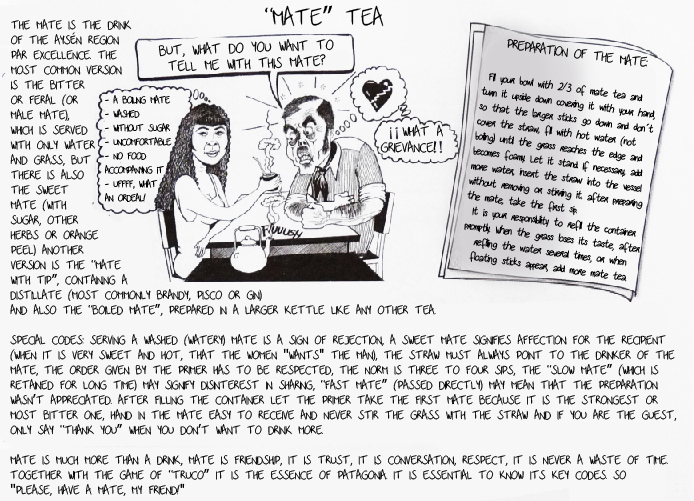
Source: Manual de Carreño de la Patagonia Aysén, 2010, Nelson Huenchuñir, Patricio Segura
We are in Coyhaique, the capital of the Aysen Province in Chilean Patagonia. (pop. 50.041 inhabitants).
We are in the kitchen of Toños’ house. It is a typical wooden house for the region built by his grandparents, who came from the big island of Chiloe around 1950.
Like the houses of yore, it has a good woodstove and ample space gatherings and meetings with family and friends. Jenny Millalonco, Clorindo Bilbao, Oscar Ziehlmann and Hugo Aguilante take part in this Mate ceremony.
At present the land where the house sits has already been sold, and the building will soon be demolished like many others of its style, making way for modern buildings, which are multiplying in Coyhaique at present.
When lambs and ewes are 3 to 4 months old, depending on the month of birth (August or September), they are marked with specifics symbols in order to be identified by their owners.
In the past, the settlers used to support each other in performing the various tasks of livestock management. The marking was a social event that brought together many farming families. When a villager invited you to mark his animals, there was certain to be a family celebration with barbecues, music, dance and fraternal conversation.
The earmark is a cut or mark in the ear to show ownership and year of birth of an animal. It consists in cutting or punching the ears either with a knife or with a tool called the “señaladora”, that has different shapes to make more complex marks.
The earmarks are permanent and determine livestock ownership. They must be legally registered in an official registry run by the municipality to which the owner belongs. The owner’s respective symbol is signed in below the RUT (ID number).
The following table shows some of the kinds of symbols used in the rural Aysen region.
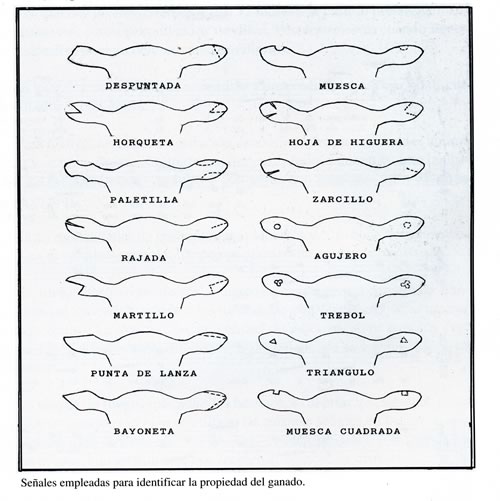
Source:Galindo, Leonel 1996. Aisen, Voces y Costumbres. Sources Ed.
The corrals as well as the smaller units “bretes”, are constructed in the region in the forms known as “Cajón” or “Tranquilla”. These fences are built with the wood available from each local area. The Cajon fence is a circular structure formed by several pairs of parallel vertical posts, each pair spaced 3 or 4 meters apart, depending on the length of the horizontal rails to be used for fencing. The posts of each vertical pair are buried 20 cm apart. Five horizontal rails, called “tranquillas”, connect one pair of post, called “tendido”, to the next.
Source: Galindo, Leonel 1996. Aisen, Voces y Costumbres. Sources Ed.
During the marking period, two additional processes are administered to the young animals: the castration of males and the tail docking both females and males.
The castration of males consists in removing the testicles in order to sterilize the animal thereby preventing an inordinate population increase within the herd. The farmer keeps only one or two males for breeding purposes, typically adult animals purchased for this reason. All males born in the yearly calving are castrated.
In the region there are three techniques for castration: by knife, elastic band and with the teeth. The last is a traditional technique associated with the rural identity of the region. Although today its implementation has been reduced, there are still families and rural areas where this technique is applied. Its called “capa a diente” castrating with teeth, and consists of one employee or family member (usually men, although occasionally women) taking the animal's testicles between his or her teeth, after having made an incision in the scrotum to free the testicles. Once the testicles are held between the teeth the castrator pulls and rips away the efferent tubes. The testicles are then placed in a container to be counted, in order to know the exact number of animals castrated.
Tail docking is a task that is performed on young female and male sheep. The tail is completely cut on the females to help breeding in the future. On males the tail is only partially cut, allowing identification among the herd.
Still practiced today, though it was more common in the past, the tails and testicles are cooked as part of the meals during the family gatherings organized during the docking and castration period.
Source: Galindo, Leonel 1996. Aisen, Voces y Costumbres. Ed OriginsWe are on the land of Don Germán Gastaminza and Doña Maria Cid, 45 km from Coyhaique, near the Paloma River in the aptly named “Boca de Leon” territory (Mouth of the lion). Their house is surrounded by forests of Lenga and Coigue (native South American wood). The parents of Don Germán, a settler from the Spanish Pyrenees and a Mapuche descendant from Temuco, arrived in the 30s to work on what would become the "Fundo Santiago".
Since than the family has been committed to livestock (cattle and sheep), which number up to 200 heads, depending on the year and the season. The farming tradition is still maintained today. Their sons Francisco and Rodrigo help with the many chores of farming, especially when castration, marking and tail docking take place to manage the livestock.
In the summertime Don Germán takes his animals up to the pastures in the mountains. In the winter they are kept closer to the house and fed the fodder, obtained from what has grown over the summer. Don Germán told us that the road to his land was only built in the 70s. Previously, the land was only accessible on horseback, and the journey could last up to 4 days. This condition of isolation is still common in some parts of the region, and is the normal way of life for many of the descendants of this region’s pioneers.
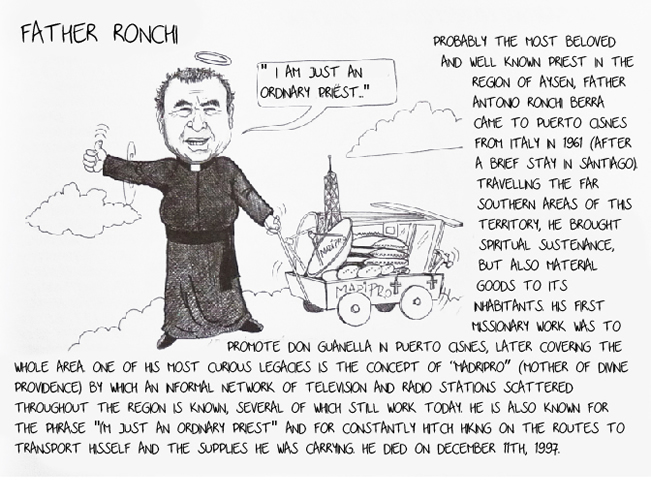
Source: Manual de Carreño de la Patagonia Aysén, 2010, Nelson Huenchuñir, Patricio Segura
Antonio Ronchi Berra was born February 12th, 1930 in a peasant village near Milan. The eldest of eleven children, he had a difficult childhood during the interwar period. At twenty, after watching a religious movie, he decided to become a priest. He chose the order of Louis Guanella to dedicate himself to the poor.
When, Father Alberto Hurtado, the founder of the “Hogar de Cristo” in Chile, knew that he had cancer, he asked Rome to send some missionaries to continue his work with children and the poor. In 1961 the Vatican responded with two priests: Francisco Belotti, who still works at the premises of the “Don Guanella work” in Coyhaique, and Antonio Ronchi. The young Ronchi started picking up children that lived under the bridges of the Mapocho river and putting them into school. He came to Aysen in order to build a home in Puerto Cisnes, where he received abandoned children brought from other regions and trained them to become settlers. He quickly understood the religious and material needs of the inhabitants of all the villages in the region. This his journey began by virtue of his impetus to achieve financial support and food for the localities where he worked as a missionary. He took advantage of this opportunity to form religious groups, construct chapels and spread the Word of God to the hearts of the Ayseninos.
His stay in Puerto Ibáñez, as well as in all other locations, is remembered very fondly. His figure is admired and revered by a significant number of the rural population who received his attention.
Sources: www.misioneros.cl, www.fundacionronchi.cl. The book "El padre Ronchi" can be purchased from the Ronchi FoundationThe traditional Ibáñez pottery is typified by a series of 6 pieces, each with its own characteristic name: epulonko, moyino, standing caiquén, lying caiquén, creole boleadora and tehuelche boleadora. Each piece is constructed in 5 different sizes and 3 different styles; traditional, slipped and double leather covered. The latter is the most expensive style, and is currently only made upon request.
There is a second series called "Huikika", composed of 7 pieces very similar to the traditional pots, but more ornate. They are called: Caiquén vigía, Caiquén cazador, Avutarda, Tetera, Boleadora Huikika, Boleadora Rosada and Alforja Huikika. These pieces are made in three sizes: large, medium and small. A miniature version is also produced, however in fewer number.

Source: Osorio, Mauricio 2010. Creando en la Tradición. La Artesanía en la región de Aysén. Unpublished book. For more information contact: Maurosoriopefaur@gmail.com
Puerto Ibáñez pottery has its origins in the late 1970s. At that time the missionary priest Antonio Ronchi motivated young women to learn how to develop products with local raw materials, i.e. clay, leather and wool. He traded these products for food and clothing from Caritas Chile and other sources. During these years Father Ronchi discussed his idea with the designer and craftsman Pedro Isla Maldonado from Chillán and invited him to work with the local women. That is how this important Chilean designer moved to Puerto Ibáñez and started training a group of young women and simultaneously began to create the designs of the now famous pottery of this town. The clay pots are characteristically covered with goatskin and decorated with figures inspired by the ancient rock paintings of the Ibáñez River valley.
Source: Osorio, Mauricio 2010. Creando en la Tradición. La Artesanía en la región de Aysén. Unpublished book. For more information contact: Maurosoriopefaur@gmail.comWe are in the workshop of Marfa Aguila and Joel "Santiago" Vargas, 117 km south of Coyhaique in the town of Puerto Ibáñez.
Marfa was part of the first generation of students instructed by Pedro Isla in the manufacturing of clay pots, a project initiated by Father Ronchi. She is one of the few who has fought, since its origins, to keep this tradition alive.
Presently work in clay has become a vocation for the entire family.
Her husband Joel works full time with her manufacturing and selling pottery, and their two children also help them during busy times.
Marfa began working in her own kitchen, but today, thanks to their success, they have been expanding on their land, building a workshop, a salesroom and a sheltered space where the clay oven is installed.
Puerto Ibáñez, like most of the towns around Lake General Carrera, enjoys a privileged microclimate that allows Joel and Marfa to grow vegetables, fruits and grain typical of central Chile in their garden and greenhouse.
The imagery observed on the traditional pottery of Puerto Ibáñez is a loose interpretation by its designer Pedro Isla Maldonado of the ancient rock paintings found in the Ibáñez river basin. Indeed, Isla visited several archaeological sites in the area, drew the motifs that most attracted his attention and then selected “graphical cells", which thereafter evolved into the typical decoration for the clay pots. However, there are two motifs that are reproduced unmodified to the pots: the famous Guanaca with Breeding located within a wall painting in the area of Villa Cerro Castillo, also known as 'site RI-4', and the Rhombus with Guard and Point that forms part of 'site RI-12b' located in the vicinity of Puerto Ibáñez.
The decoration that began to appear on utilitarian pottery around 1997 in the same locality is very different. This production line is decorated much more freely by the craftswomen. Several different designs can be found: pieces decorated with designs inspired by Selknam culture, pieces with traditional motifs of the local pottery, and also pieces with the personal designs from the craftswomen themselves. This gives the product line variety and a different aesthetic in contrast to the traditional pottery. Both approaches enhance each other’s potential, allowing this beautiful craftwork to be maintained in the Aysen region.
Source: Osorio, Mauricio 2010. Creando en la Tradición. La Artesanía en la región de Aysén. Unpublished book. For more information contact: Maurosoriopefaur@gmail.com
According to literature, the origin of the wooden shingles can be traced back to Europe, especially to the Germanic peoples. An article in the Journal AITIM No. 199, 1999 (http://infomadera.net/modulos/revista.php?id=199&a=3565#A3565) writes that the Roman chroniclers already observed the use of this covering material on the houses of Germanic communities. The wooden shingles are also known by the name of “chilla" in Europe.
In Chile, this building material called “pizarrilla” (little blackboard) was rarely used during the colonial period. Its rise in popularity was due to the German settlers in Llanquihue and Puerto Montt, who used the pizarrillas to bestow grace and elegance upon their buildings. The wooden shingles made of “Alerce” wood are long, thin and narrow, and mounted on one another to prevent the penetration of rain. Only one third of its total length is outwardly visible, and its design depends on the various methods of cutting the tablet. Originally, the wooden shingles were 90x15x1 cm, but currently they are 50x12x1 cm.
Source: www.chiloeweb.com/chwb/chiloeisland/tem_gen_arquitectura.html
The use of wooden shingles as cladding material as well as for the roofs of houses in the Aysen region was introduced by master builders from Chiloe, who arrived in the early decades of the 20th century. Although there has been no complete historical study regarding the arrival of this building style in the region, it is known that the boom in the shingles’ use took place by the early fifties. In the Mayer region, for example, the first house covered with wooden shingles was built in 1953 by the teachers Vargas and Villegas. Before this house, the settlers had only built wooden houses with posts and Canoga roofs.
The wooden shingles of the Aysen region are generally made of Lenga wood (Nothofagus pumilio), although the artisans also work with Cordillera cypress (Austrocedrus chilensis), Guaitecas cypress (Pilgerodendron) and Mañio (Podocarpus nubigena).
According to Carlos Castillo Levicoy, a forest engineer and researcher in wooden shingles, the trade has spread throughout the region, without variations in technology or manufacture method. The tools used are a "machete", a knife with a blade set in a 90° angle from the handle, and the "combo", similar to a hammer made of wood. The machete blade is placed on top of the piece of wood from which the shingles are cut, and then the combo is hammered on the machete’s upper edge.
Regarding the shingles’ design, there is an assortment of shapes. The design chosen for each house depends on the craftsman and the customer. However, the classic design is a rectangle, followed by a trapezoid with diagonally cut edges.
We are close to the Rio Cajon river, about 40 km south of the town of Villa Cerro Castillo, at one of the highest points on the road to Bahía Murta. During the month of December, Crispin Castillo lives in a modest, self constructed camp and manufactures wooden shingles at about 50 meters from the Carretera Austral road in the middle of a dense forest of “Lenga”, “Magellan Coigue” and “Ñirre” trees. The "tejueleo point" (location where the wooden shingles are manufactured) can change from year to year, depending on its accessibility and timber availability.
Don Crispin is a man who works independently. Sometimes he is accompanied by his sons, who are becoming experts in their fathers’ skills. He starts work at dawn and restricts his output to 350 to 400 shingles per day. In the past many settlers used to make shingles for their houses, a practice that has been lost over the years. Presently, Don Crispin is known for being perhaps the only one in the region who lives exclusively from the manufacture of wooden shingles.
The use and exploitation of timber in the Aysen region has been a cultural constant since ancient times. The indigenous island tribes “Kawésqar” and “Chono” used it as firewood, to build boats and temporary housing, and as shafts for tools and weapons. On the mainland, the indigenous “Tehuelche” and “Mapuche Huilliche” tribes also used timber for building shelters, tools and even household utensils.
In the 18th and 19th centuries, the largest exploitation of the coastal Aysen forests took place when crews of loggers from the island of Chiloe extracted trunks of Cypress and other species to trade with the north of the country. They became pillars both for the railway lines as well as vine cultivation, which gradually increased in the centre of the country.
The work of the manufacturing posts from the Guaitecas Cypress, formerly a primary source of employment in the south of the region, is almost extinct today.
In timber, the historical settlers of the region found a resource to build houses. Although very modest, these homes were expressions of their struggle with the environment, and their determination to inhabit Aysen. However they also burned huge tracts of forests to make way for grassy fields and the cultivation of crops and livestock.
Gradually, they learned how to utilize the forest: as firewood and building material to sell in towns and cities, as a space for feeding cattle in winter, and more recently as an area for the extraction of other resources that exist in relative abundance within the forests of Aysen.
Source: Osorio, Mauricio 2002. The Culture of wood in Aysen. Unpublished.
More information: www.conaf.cl
We are in the eastern part of Chilean Patagonia, on the southern coast of Lake General Carrera, near one of the many border crossings of the shared 5,150 km border between Chile and Argentina. Here in the south of the Andes mountain range, many people would say that they feel “more Patagonian than Chilean or Argentinean", because cultures have been mixing and influencing each other for many years. Here in Patagonia the friendship between these two nations is apparent; they not only share the landscape and music but also the style of dress and games.
The table where the “Truco game” takes place is located next to a rodeo stadium, a typical and traditional equestrian sport both in southern Chile and Argentina. The rodeo is traditionally accompanied by "payas", songs in ten-syllable verses describing the performance of each participant.
The players in this truco game are Claudio Vasquez a.k.a. "Petaca" and Luis Vasquez, a pair of Chilean brothers connected with horse racing and rodeos, and Negro Falucho y Guillermo Marín a couple of Argentinean minstrels “payadores” at the same event.
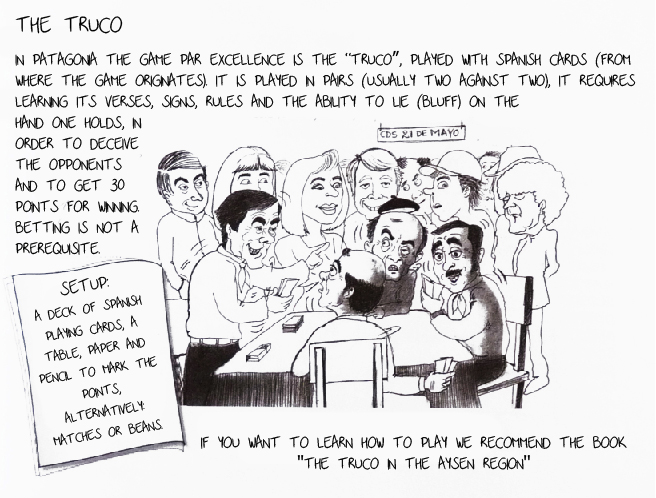
Source: Manual de Carreño de la Patagonia Aysén, 2010, Nelson Huenchuñir, Patricio Segura
El Truco es un juego de naipes que utiliza la baraja española. En Chile se juega principalmente en las regiones de Aysén y Magallanes. Hoy en día el Truco se ha extendido a otras zonas del sur y centro sur del país, llevado por estudiantes universitarios originarios de las regiones mencionadas y ha sido aceptado de buena manera en los ambientes universitarios.
Al hablar de su historia, la mayor parte de los investigadores plantea que los orígenes del juego se remontan a España, donde desde época remota se jugaba Mus, Truque y otros juegos que podrían relacionarse con el Truco.
Viterbo Aguilar, si bien recoge también la evolución desde estos juegos españoles, prefiere plantear que el Truco se habría originado en la Patagonia, al alero de ruedas de jugadores que poco a poco y anónimamente iban acordando normas y estilo para un juego que pasó a llamarse Truco. Sus antecesores, no pueden ser considerados como Truco, sino como juegos distintos. Aguilar considera clave en la aparición del Truco, el contexto cultural que le dio vida y con ello nos propone una explicación
Source: Aguilar, Viterbo 2008. El Juego del Truco en Aisén. Autoedición. Galindo, Leonel 2004. Aisén y su folclor. Autoedición.
When Truco is played by 4 people in pairs of 2, or by 6 people in pairs of 3, signs can be made between partners, in order to covertly plan moves, taking into account not only their own cards but also of their partners.
The first player of the team to play, called the “Hand”, usually gives signs the one who plays last, called “Foot”, who in turn tells the “Hand” what to do.
The Signs of Truco are:
Ace (called "anchos" all aces) of spades: raise right eyebrow
Ace of clubs: blink left eye
7 of spades: stretch the corners of the lips on the right side of the mouth
7 of diamonds: stretch the corners of the lips on the left side of the mouth
Any 3: Bite the lower lip
Any 2: Place your lips as if throwing a kiss
Ace of hearts or diamonds (or “false ancho”): open and close the mouth
For the lowest cards: close both eyes (meaning that you are “blind” or have nothing to play)
Having “tanto” (27, 28 or 29 points): Nod the head to the right or left
Having “tanto” (30 points or more): Wiggle the nose
It is generally considered unethical if the partners who know each other in advance use secret signs other than the official signs to communicate their cards. Sometimes penalties are established, such as extra points for the opposing team when they discover the trick.
Truco is the most popular card game played in the area. It can be played between two or more players with different variants: one against one "Hand in Hand"; with three players "Rooster Truco" and in pairs of to known as “The Fourth”. The name “Truco” (trick) is derived from its methodology. It depends on the player's skills, since one can win without having good cards, and by lying and deceiving the opponents into making them quit a bet.
The only thing you need to play is a deck of Spanish playing cards, paper and pencil, or any other item to count points, e.g. matches, beans, anything small available in large quantities.
Card Values From highest to lowest value: 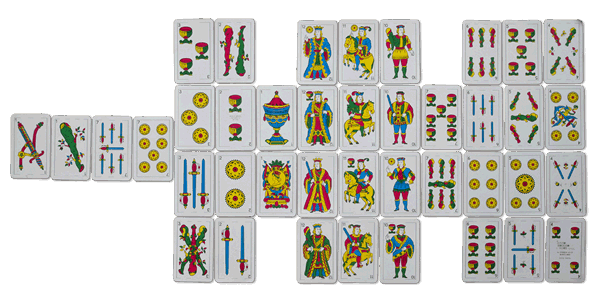
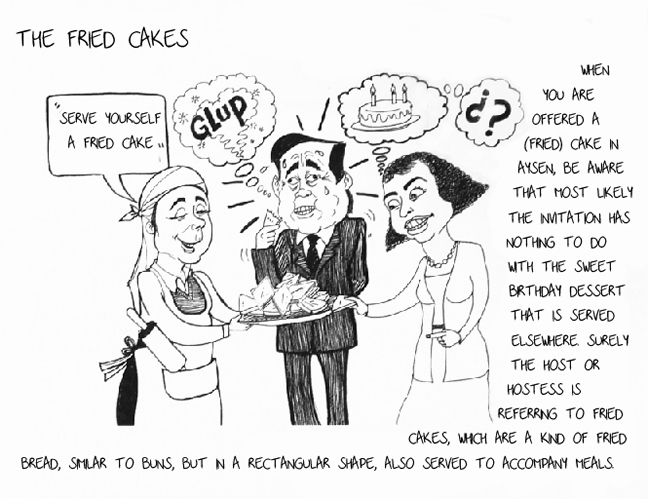
Source: Manual de Carreño de la Patagonia Aysén, 2010, Nelson Huenchuñir, Patricio Segura
Throughout the countryside, the rural women have developed a practical and experimental knowledge about the vegetation suitable for dyeing wool fibers. The colors obtained from plants, shrubs and trees in Chile are generally similar and can be found in a range of yellows, browns and greens, and in some cases even grey and black.
In the Aysén region there is a diversity of flora that provides dyes for wool. The following species are of note:
Trees: Huinque or fuinque; various shades of brown can be obtained from its bark. Canelo; shades of green can be obtained from its leaves and bark. Poplar and birch; shades of green can be obtained from its bark.
Shrubs: Calafate, shades of yellow can be obtained from its bark, and a purple or violet hue from its fruits; Michay, its bark yields a yellow-orange. Shades of purple are attainable from the fruits of the Maqui, and the Retamo yields shades of green.
Plants: There are a variety of plants used for dyeing; The roots of the “Nalca” or “Pangue” are used to attain shades of grey. Mixed with “Maqui” fruit, one can produce a black color. Yellow dock leave, mint or peppermint, chamomile and other plants create varieties of yellow and soft greens.
Sources:
Osorio, Mauricio 2010. Creando en la Tradicion. La Artesanía en la región de Aysén. Unpublished book. For more information contact: Maurosoriopefaur@gmail.com
Marzocca, Angel, 1959. History of dyeing and tanning plants. INTA, Buenos Aires.
Artisans, also known in the region as “tejenderas” (Galindo, 1996), use three types of loom for weaving as per their family tradition:
Vertical or Mapuche Loom
A loom made from two wooden sticks about 2 to 3 meters long placed vertically against a wall. In addition two thinner rods are added horizontally to form a rectangle. The artisan weaves while sitting or sometimes standing on this type of loom.
Horizontal or Chilote loom
Also known as “Quelgo”. A type of loom that is assembled on the ground and therefore causes a horizontal orientation of the warp. It also requires the weaver to assume a specific position - sitting or kneeling for long periods of time.
Pedal loom
A type of weaving that is horizontally oriented, but mounted on a high structure that allows the artisan to remain seated while working. The pedal loom can produce very long pieces of fabric.
In recent years other types of looms have reached the region. One of them is designed for use on a table – which takes up less space in the home.
Source: Osorio, Mauricio 2010. Creando en la Tradicion. La artesanía en la region de Aysén. Unpublished book. For more information contact: Maurosoriopefaur@gmail.com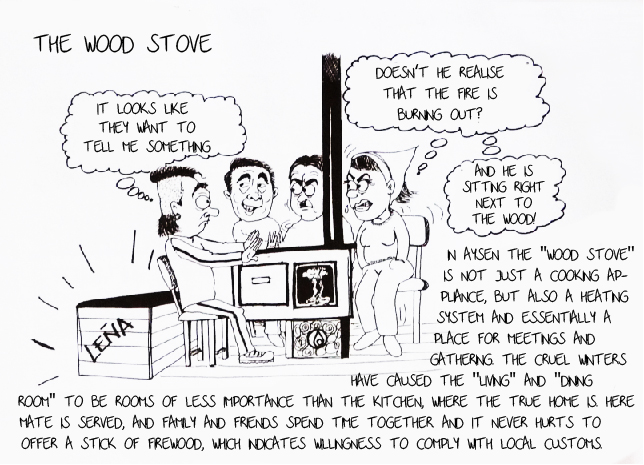
Source: Manual de Carreño de la Patagonia Aysén, 2010, Nelson Huenchuñir, Patricio Segura
The wood stove is a common feature of homes in the Aysen region, like in many areas of southern Chile. It fulfills several purposes in the household, the most important of which are cooking and heating the house.
The wood stove replaced the open fire place “fogón”, an enclosure designed by the pioneer families to prepare food and hold family gatherings. This replacement is both, functional and symbolic, since the stove has made food preparation more efficient and still keeps the traditional space for family gatherings.
In Aysen the space for the kitchen, as well as the stove, has historically been the most important space inside the house, being the place where most of the day to day activities occur and therefore it is given priority over other rooms, even the bedrooms.
It is believed that the wood stove was adopted in the early 20th century, both on the ranches and by settler families, who as soon as they could, purchased a stove in cities in Argentina or even in Punta Arenas.
There are currently two factories producing wood stoves in the region, both located in the city of Coyhaique. Many stores also offer stoves manufactured in Temuco and Valdivia.
We are on the land of Doña Elisa Ramirez in Puerto Vagabundo, located about 105 km south of Cochrane. Her land is the place where the Carretera Austral road formerly ended and where the pier was located to continue the journey to Caleta Tortel by boat.
Here she lives with her partner Don "Checho" and her grandson Leonel, also accompanied by several animals that are part of the household, among which the dog "Mentira” (“Lie”) plays an important role.
The Vagabundo area is known for its rainy climate and abundant vegetation. On the land of Doña Elisa, which spreads widely along the banks of the Baker River, the family has cows, goats, chickens and ducks. Besides having a forest with wild raspberries, they also cultivate all types of greenhouse vegetables: carrots, fennel, spinach, lettuce and weeds.
Doña Elisa spins, dyes and works wool next to her wood stove and in her small workshop to create blankets, caps and jackets for both, for her family and to sell. To dye the wool, Doña Elisa only uses organic products, which could be the bark of a tree, the fruits of caulker and a number of products from the land.
Only steps away from her house is the grave of a Tehuelche woman, kidnapped in Caleta Tortel by her lover and brought to Vagabundo by row boat early last century. The wooden cross that marks the grave is made of Guaitecas Cypress and it is still in good condition.
Even today, Vagabundo is still a very isolated region. Twice a week a boat sent by the community of Tortel brings supplies to the settlers along the riverbank. In the rainy season the road might be closed for several days. And the only communication device that Elisa has to speak with people in Tortel is an old radio-telephone.